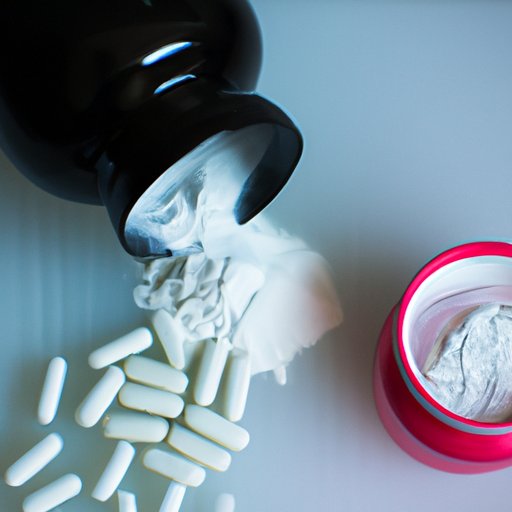
I. Introduction
Creatine is a popular supplement used by athletes and bodybuilders to boost performance, build muscle mass, and improve recovery. But with so many different opinions on how much to take and how often, it can be difficult to know where to start.
In this article, we’ll explore the science behind creatine supplementation, the dosages and frequencies recommended by experts, and how to use creatine safely and effectively for optimal results. Whether you’re a novice or an experienced athlete, this guide will help you navigate the world of creatine use.
II. The Science Behind Creatine Supplementation: How Often Should You Take It?
Creatine is a naturally occurring compound found in the body that plays a key role in energy production. During high-intensity exercise, the body converts stored creatine into ATP (adenosine triphosphate), the primary energy source for muscle contraction.
Research has shown that supplementing with creatine can increase muscle creatine stores by up to 40%, leading to improved athletic performance, increased muscle strength, and faster recovery times.
Creatine is available in several forms, including creatine monohydrate, creatine hydrochloride, and creatine ethyl ester. While each form has unique characteristics and effects, most studies have focused on creatine monohydrate, which is widely considered the gold standard of creatine supplements.
So, how often should you take creatine? According to experts, the key is to maintain consistent levels of creatine in the body by taking it daily at a dose that’s appropriate for your body weight and training goals.
III. Experts Weigh In: Optimal Creatine Dosages and Frequency for Athletic Performance
The optimal dosage for creatine varies depending on factors such as body weight, training intensity, and individual response. However, most experts recommend starting with a loading phase of 20 grams per day split into four doses for five to seven days, followed by a maintenance phase of three to five grams per day.
Some experts suggest taking creatine before and after workouts to maximize its effects, while others recommend taking it at the same time each day regardless of exercise timing.
Research studies have shown that taking creatine daily can lead to significant improvements in muscle strength, power, and endurance, as well as reduce muscle damage and fatigue.
IV. Debunking the Myths about Creatine: How Much and How Often?
Despite its proven benefits, creatine supplementation is often the subject of myths and misconceptions. One common concern is that creatine causes water retention and bloating. However, research has shown that any initial weight gain from creatine is due to increased water retention in muscle cells, not subcutaneous tissue.
Another myth is that creatine can damage the kidneys. However, multiple studies have shown that creatine does not pose a risk to healthy kidneys, and may even have protective effects against age-related decline in kidney function.
When it comes to determining how much creatine to take, experts recommend a dosage of five grams per day for maintenance, with the option to increase or decrease based on individual needs and tolerance. To calculate dosage based on body weight, simply multiply your weight in kg by 0.03.
V. A Comprehensive Guide to Creatine: Timing, Dosage, and Frequency
Based on the research and expert opinions presented above, we can conclude that the optimal frequency for creatine intake is daily, with a loading phase of 20 grams per day divided into four doses followed by a maintenance phase of three to five grams per day.
Timing of creatine intake can vary based on individual preferences, but many athletes choose to take it before or after workouts to maximize its effects on muscle recovery and growth.
For those new to creatine use, it’s important to start with a low dosage and gradually increase as tolerated to minimize potential side effects. Additionally, it’s important to stay hydrated while taking creatine to prevent dehydration and maintain healthy kidney function.
VI. From Novice to Advanced: Creatine Usage Guidelines for Athletic Progression
For beginners and novice athletes, it’s important to follow the recommended dosage and frequency guidelines presented in this article to ensure safe and effective use of creatine. As athletes progress in their training, they may choose to increase their dosage or alter timing based on individual preferences and goals.
Advanced athletes may consider using a more targeted creatine regimen, such as cycling on and off the supplement or taking additional forms of creatine such as creatine nitrate. It’s important to consult with a qualified coach or healthcare provider before making any significant changes to your supplementation routine.
VII. Navigating Creatine Use: How Often Should You Take It to Avoid Unwanted Side Effects?
Potential side effects of creatine supplementation include gastrointestinal distress, muscle cramping, and dehydration. However, these side effects can generally be avoided by following proper dosing and hydration guidelines, as well as consulting with a healthcare provider before starting a creatine regimen.
To prevent or minimize side effects, it may be necessary to adjust dosage or frequency based on individual factors such as age, health status, and training level. Additionally, it’s important to choose a high-quality creatine supplement from a reputable brand to ensure purity and safety.
VIII. Conclusion
In conclusion, creatine can be a valuable tool for improving athletic performance, building muscle mass, and enhancing recovery. Understanding how often to take creatine is key to achieving optimal results while avoiding unwanted side effects.
By following the dosing and frequency guidelines presented in this article and consulting with a healthcare provider or qualified coach, athletes of all levels can use creatine safely and effectively to support their training goals.





